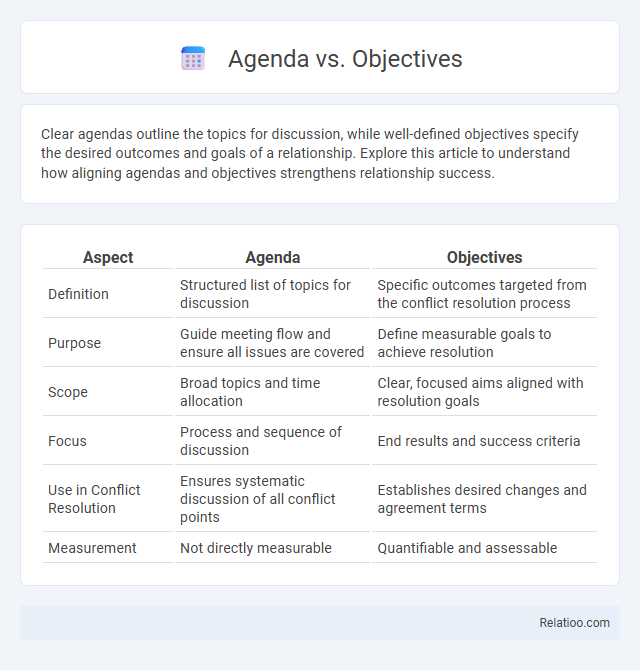Clear agendas outline the topics for discussion, while well-defined objectives specify the desired outcomes and goals of a relationship. Explore this article to understand how aligning agendas and objectives strengthens relationship success.
Table of Comparison
| Aspect | Agenda | Objectives |
|---|---|---|
| Definition | Structured list of topics for discussion | Specific outcomes targeted from the conflict resolution process |
| Purpose | Guide meeting flow and ensure all issues are covered | Define measurable goals to achieve resolution |
| Scope | Broad topics and time allocation | Clear, focused aims aligned with resolution goals |
| Focus | Process and sequence of discussion | End results and success criteria |
| Use in Conflict Resolution | Ensures systematic discussion of all conflict points | Establishes desired changes and agreement terms |
| Measurement | Not directly measurable | Quantifiable and assessable |
Understanding the Concepts: Agenda vs Objectives
Understanding the concepts of agenda and objectives clarifies meeting planning and goal setting. An agenda outlines the topics and structure of a meeting, serving as a roadmap to ensure all necessary points are covered. Objectives define specific, measurable outcomes you aim to achieve during or after the meeting, guiding your focus and decision-making process.
Key Differences Between Agenda and Objectives
An agenda outlines the planned topics and activities for a meeting or event, serving as a structured timetable to guide participants through the session. Objectives define the specific goals or desired outcomes that the meeting or event aims to achieve, focusing on what participants should accomplish by the end. The key difference lies in the agenda detailing the "how" and "when" of the session, while objectives clarify the "why" and "what" that measure the session's success.
Importance of Setting Clear Objectives
Setting clear objectives ensures you can measure progress and stay aligned with your desired outcomes during meetings or projects. While the agenda provides a structured outline of topics to discuss, objectives define the specific goals you aim to achieve, enhancing focus and productivity. Clear objectives improve decision-making and help your team prioritize tasks effectively.
Crafting an Effective Agenda
Crafting an effective agenda requires clearly distinguishing it from the meeting objectives and purpose; the agenda outlines the specific topics, timing, and sequence, while objectives define the desired outcomes and goals to be achieved. An optimized agenda ensures focused discussion by aligning each item with corresponding objectives, enhancing productivity and time management. Structuring the agenda with precise action points and relevant data drives engagement and helps participants prepare effectively for the meeting.
Role of Objectives in Meeting Success
Objectives define the specific outcomes your meeting aims to achieve, providing clear direction and measurable goals that guide the agenda's structure. Well-crafted objectives ensure each agenda item aligns with desired results, maximizing participant engagement and meeting efficiency. Your meeting success heavily relies on setting precise objectives to maintain focus and drive productive discussions.
How Agendas Support Achieving Objectives
Agendas provide a structured framework that aligns meeting activities directly with your objectives, ensuring focused discussions and efficient time management. By clearly outlining topics and time allocations, agendas keep the team on track, facilitating progress toward specific goals. This alignment between agendas and objectives enhances accountability and increases the likelihood of successfully achieving desired outcomes.
Common Mistakes: Confusing Agenda with Objectives
Confusing agenda with objectives is a common mistake that can lead to ineffective meetings and unclear outcomes. Your agenda outlines the topics and sequence of discussion, while objectives define the specific goals you want to achieve by the end. Distinguishing between these two ensures productive planning and clearer communication.
Aligning Agendas with Organizational Goals
Aligning agendas with organizational goals ensures that each meeting's objectives directly contribute to your company's strategic priorities, maximizing productivity and focus. Clear objectives provide measurable outcomes, while a well-structured agenda keeps discussions on track and relevant to key performance indicators. By synchronizing agendas and objectives with overarching goals, teams can drive consistent progress and achieve desired results efficiently.
Best Practices for Defining Agendas and Objectives
Effective meeting management hinges on clearly distinguishing between agendas and objectives to enhance productivity and focus. Best practices for defining agendas include outlining specific topics, allocating time slots, and assigning presenters, while objectives should be measurable, outcome-driven, and aligned with organizational goals. Combining well-structured agendas with SMART (Specific, Measurable, Achievable, Relevant, Time-bound) objectives ensures purposeful discussions and actionable results.
Summary: Maximizing Outcomes with Clear Agendas and Objectives
Clear agendas outline the structure and flow of your meeting, ensuring time-efficient discussions and well-organized topics. Specific objectives define the desired outcomes, providing measurable goals to guide participants' focus and efforts. Combining agendas with objectives maximizes productivity by aligning meeting content with targeted results, helping you achieve your goals effectively.

Infographic: Agenda vs Objectives
 relatioo.com
relatioo.com